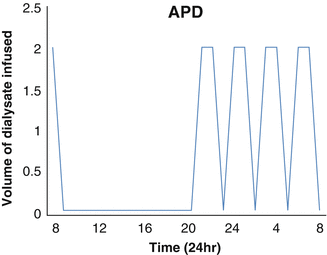and Christopher Isles2
(1)
Institute of Cardiovascular and Medical Sciences, University of Glasgow, Glasgow, UK
(2)
Dumfries and Galloway Royal Infirmary, Dumfries, UK
Q1 What is PD and how does it differ from haemodialysis?
PD is a gentler form of renal replacement therapy than haemodialysis. Whereas an artificial membrane filters the blood in haemodialysis, peritoneal dialysis exploits the peritoneum as a natural semi-permeable membrane. It is usually performed by patients in their own homes. It involves running 2–2.5 litres of warmed dialysis fluid into the abdominal cavity using a thin rubber tube known as a Tenckhoff catheter, then waiting a few hours before draining the fluid out and infusing fresh fluid. This exchange of fluid takes around 20–30 min and is simple to learn. Most patients are competent after 2 days practice. The Tenckhoff catheter and the peritoneal membrane are to peritoneal dialysis, as vascular access and the artificial dialyser are to haemodialysis (Fig. 38.1).


Fig. 38.1
Principles of peritoneal dialysis
Q2 How does peritoneal dialysis work?
In peritoneal dialysis, blood is filtered inside the body. Given the vast surface area and system of pores within the peritoneum, it acts as an ideal dialysis membrane. Blood is filtered through two mechanisms:
1.
Solute transport – this is the movement of waste products (urea, creatinine and electrolytes) through simple diffusion down favourable concentration gradients. Dialysate contains balanced electrolyte solutions and lactate to correct acid-base disturbance.
2.
Ultrafiltration – this is the movement of fluid out of peritoneal capillaries. It is driven by the osmotic gradient generated by the glucose-rich hyperosmotic dialysate.
Both processes are shown in the figure that follows. Most patients on CAPD will do 4 × 2 litre exchanges for solute removal with light (1.36 % glucose), medium (2.27 % glucose) or heavy (3.86 % glucose) bags for fluid removal. A patient with normal blood pressure and no oedema might be on 4 light bags. The more hypertensive and oedematous the patient the more benefit they will gain from medium and heavy bags (Fig. 38.2).


Fig. 38.2
Principles of solute transport and ultrafiltration across a semipermeable membrane
Q3 What is meant by the term CAPD?
Continuous ambulatory peritoneal dialysis (CAPD) is the term used to describe patients who run the PD fluid in and out themselves, and usually means four 2 litre exchanges each day. The timing of exchanges is not critical although patients usually do one when they get up in the morning, one at lunch time, one at teatime and one as they go to bed. This effectively gives them three 4–5 h dwells and one longer overnight dwell of 9–10 h (Fig. 38.3).


Fig. 38.3
CAPD exchanges demonstrating 3 day time exchanges and an overnight dwell
Q4 What is meant by the term APD?
Automated PD (APD) means programming a small bedside machine to exchange fluid automatically at night whilst the patient is asleep instead of undertaking manual exchanges of fluid through the day. CAPD and APD are interchangeable and some patients do both (Fig. 38.4).


Fig. 38.4
APD. In this form of RRT, the patients have the option of being “dry” or “wet” during the day depending on whether further exchanges are required. The prescription above is for a patient who is dry during the day
Q5 Most patients choose APD rather than CAPD. Why?
The advantages to a patient of APD are as follows:
APD gives the patient more daytime freedom.
Less connections therefore less infection.
More fluid and therefore more dialysis.
Shorter dwell times and therefore better ultrafiltration.
Less abdominal fullness because patient is supine during dialysis, therefore better appetite and less risk of hernia.
Q6 How do you judge whether a PD patient is adequately dialysed?
PD adequacy is judged on the following three parameters:
1.
Clinical assessment – the well dialysed patient has a good appetite, no nausea, minimal fatigue and feels well.
2.




Solute removal – we measure this by 24 h urine and PD fluid collection, together with a serum sample, to give total creatinine clearance in litres per week. Total creatinine clearance equals residual renal function plus peritoneal clearance. Current guidelines recommend a target of 50 litres per week for both CAPD and APD patients.
< div class='tao-gold-member'>
Only gold members can continue reading. Log In or Register to continue
Stay updated, free articles. Join our Telegram channel

Full access? Get Clinical Tree








